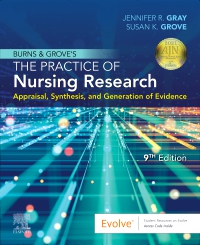
Burns and Grove's The Practice of Nursing Research, 9th Edition
Paperback

Now $98.59
Winner of the 1st-place American Journal of Nursing Book of the Year award in nursing research/evidence-based practice for 2021!
**Selected for Doody’s Core Titles® 2024 with "Essential Purchase" designation in Research**
Burns & Grove’s The Practice of Nursing Research: Appraisal, Synthesis, and Generation of Evidence, 9th Edition is the trusted resource for those wanting to master the research methods that are foundational to evidence-based practice. This highly respected textbook covers how to appraise and apply existing research evidence, as well as how to participate in research and quality improvement projects. This new 9th edition has been extensively updated to reflect today’s focus on online research in the digital era and includes clear, step-by-step guidelines for all major quantitative and qualitative research approaches — including supporting examples from the latest high-quality literature. There’s also new content on translational research, coverage of the most current research tools and techniques, and an increased use of illustrations, tables, and other visuals to help engage visually oriented readers of all levels.
Newer Edition Available
Burns and Grove's The Practice of Nursing Research: Appraisal, Synthesis, and Generation of Evidence
-
- Coverage of quantitative, qualitative, and other research methodologies provides a solid foundation to conduct, appraise, and apply research evidence to the realities of today's clinical practice.
- Balanced coverage of qualitative and quantitative methods addresses the qualitative research methodologies that are often the starting point of research projects, particularly in magnet hospitals and DNP programs.
- Clear, comprehensive coverage is organized into five units that include: an introduction to nursing research; coverage of the research process; application for evidence-based health care; how to analyze data, determine outcomes, and disseminate research; and how to propose and seek funding for research.
- Strong emphasis on evidence-based practice addresses this key graduate-level QSEN competency and reinforces how to generate research evidence and appraise and synthesize existing research for application to clinical practice.
- Rich examples from nursing literature bring research principles to life.
- Emphasis on the most currently used research methodologies focuses on the methods used in both quantitative research and qualitative research, as well as outcomes research and mixed-methods research.
- Coverage of digital data collection examines the use of online research tools.
- Quick-reference summaries include a table of research methods inside the front cover and a list of types of research syntheses (with definitions) inside the back cover.
- Helpful user resources are included with each new text purchase on the companion Evolve website and feature 400 interactive review questions along with a library of 10 full-text research articles.
-
- NEW! Extensively updated content reflects the most current quantitative and qualitative approaches to nursing research, as well as the most current research tools and techniques used in the digital era.
- NEW! Updated research examples throughout incorporate the best examples of current literature, with increased emphasis on international examples to reflect the increasingly global nature of nursing research.
- NEW! Increased use of visuals includes the addition of more illustrations, tables, and boxes to help break up long passages of text for today’s more visually oriented learners of all levels.
- NEW! Revised chapters offer improved clarity and usability in the areas of research problems and purpose, quantitative research design, quantitative methodology, and qualitative methodology.
- NEW! Increased emphasis on hospital magnet status reflects the effect this status has on improving nursing competency and quality outcomes.
- UPDATED! Coverage of certain qualitative research content has been de-emphasized to reflect the decreased use of certain methodologies (e.g., historical research) and to allow the introduction of additional methodologies that are growing in use.
-
Unit One: Introduction to Nursing Research
1. Discovering the World of Nursing Research
2. Evolution of Research in Building Evidence-Based Nursing Practice
3. Introduction to Quantitative Research
4. Introduction to Qualitative ResearchUnit Two: The Research Process
5. Research Problem and Purpose
6. Objectives, Questions, Variables, and Hypotheses
7. Review of Relevant Literature
8. Frameworks
9. Ethics in Research
10. Quantitative Methodology: Noninterventional Designs and Methods
11. Quantitative Methodology: Interventional Designs and Methods
12. Qualitative Research Methods
13. Outcomes Research
14. Mixed Methods Research
15. Sampling
16. Measurement Concepts
17. Measurement Methods Used in Developing Evidence-Based PracticeUnit Three: Putting It All Together for Evidence-Based Health Care
18. Critical Appraisal of Nursing Studies
19. Evidence Synthesis and Strategies for Implementing Evidence-Based PracticeUnit Four: Analyzing Data, Determining Outcomes, and Disseminating Research
20. Collecting and Managing Data
21. Introduction to Statistical Analysis
22. Using Statistics to Describe Variables
23. Using Statistics to Examine Relationships
24. Using Statistics to Predict
25 Using Statistics to Determine Differences
26. Interpreting Research Outcomes
27. Disseminating Research FindingsUnit Five: Proposing and Seeking Funding for Research
28. Writing Research Proposals
29. Seeking Funding for ResearchAppendices
Appendix A: Z Values Table
Appendix B: Critical Values for Student's t Distribution
Appendix C: Critical Values of r for Pearson Product Moment Correlation Coefficient
Appendix D: Critical Values of F for α = 0.05 and α = 0.01
Appendix E: Critical Values of the χ2 Distribution
Appendix F: Statistical Power Tables (Δ = Effect Size)Glossary



 as described in our
as described in our 